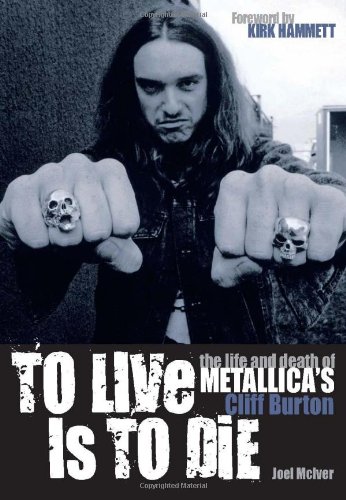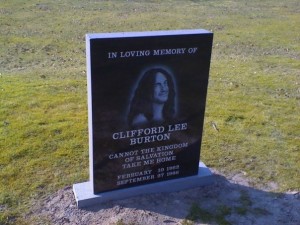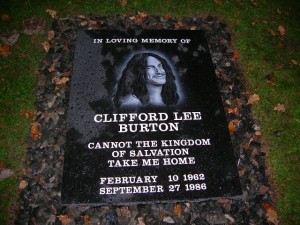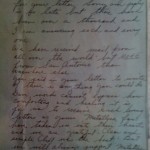
IRON FISTS: Ross Halfin’s classic Cliff photo adorns the cover of McIver’s book. The foreword was written by Cliff’s fellow San Fransican band mate, guitarist Kirk Hammett, who lost the bet to sleep in the bunk that became Cliff’s deathbed.
By Metal Dave
Anyone who thinks Cliff Burton has been turning in his grave since “Master of Puppets” may have to reconsider after reading Joel McIver’s 2009 biography, “To Live is to Die: The Life and Death of Metallica’s Cliff Burton.”
According to the author’s interviews with band mates, friends, family and peers, Cliff was actually Metallica’s most sensitive, musically sophisticated and intellectually open-minded member until his tragic death in a 1986 tour bus crash.
While it’s hard to imagine Cliff cutting his hair and trading his Misfits shirt for crushed-velvet pimp suits during Meh-tallica’s late-’90s “Load” and “Re-Load” era (a point even McIver doubts), “To Live is to Die” nonetheless invites a world of possibilities as it reveals Cliff to have been well-versed in Bach, Stanley Clarke and such non-metal bands as R.E.M., Lynyrd Skynyrd and the Velvet Underground (“Lulu,” anyone?).
Metallica purists (myself included) like to romanticize the notion that their beloved whiplash thrasher would loathe the ambitious musical avenues taken by his surviving band mates. After reading McIver’s book, however, we learn that Cliff was so much more than just a walking middle finger. We also come to realize he may indeed be resting in peace.
CLIFF BITS
Other points of interest from “To Live is to Die”:
On Cliff’s signature bass solo, “Anesthesia (Pulling Teeth)”
McIver writes, “which other player could convince James Hetfield and Lars Ulrich to hand over four minutes of precious vinyl for a bass solo?” Good point!
On Cliff’s early inspiration
In a cruel twist of fate, Cliff took up bass guitar as a tribute and distraction of sorts following the childhood death of his older brother (Sadly, Cliff would be the second child buried by Mr. and Mrs. Burton).
On Cliff in general
He drove a beat-up VW Beetle nicknamed “The Grasshopper;” he used Finesse shampoo because it came in an easy-to-pack, flat bottle; he hated the Metallica song “Escape,” because he deemed it to be a blatant stab at radio airplay (it was); and he smoked pot and drank beer, but refrained from the obnoxiously destructive shenanigans of Metallica founders, James Hetfield and Lars Ulrich.
On Cliff’s death
While it’s widely accepted the tour bus crash that killed Cliff in Sweden was caused by black ice, McIver relays a number of eyewitness and weather expert accounts that dispute the presence and plausibility of ice. This coupled with a lack of evidence pointing to mechanical failure, suggests the blame for the crash falls at the feet of the still-unidentified bus driver. We may never know.

FADE TO BLACK: Although memorial stones exist in Cliff’s honor, he was actually cremated and had his ashes scattered near his hometown of Castro Valley.
On the aftermath of Cliff’s death
Barely out of their teens, the surviving members of Metallica were still too young to have lost a parent, let alone a friend and band mate, when their eldest comrade was violently killed at the zit-pocked age of 24. As McIver points out, the rushing flood of fame (mixed with alcohol) only worsened Metallica’s collective anxiety and confusion.
 Disclaimer
Disclaimer
Despite McIver’s tendency to dissect each Metallica album and song in lingo only a musician could appreciate (triplets, etc.), the author offers enough layman’s language to keep the book plenty interesting and insightful for both the casual fan and hardcore enthusiast. Plus, McIver gets loads of extra credit for passionately spotlighting one of metal’s most mysterious, yet influential figures. A Burton book was long overdue and is greatly appreciated.
Overall Grade: B+
For video of the unveiling of Cliff’s memorial stone, go here.
 On a personal note, I was shocked to receive a handwritten letter (right) from Mrs. Jan Burton following the passing of her son, Cliff. It remains one of my most prized possessions and is hanging on my office wall in front of me as I type this. For the full story, go here.
On a personal note, I was shocked to receive a handwritten letter (right) from Mrs. Jan Burton following the passing of her son, Cliff. It remains one of my most prized possessions and is hanging on my office wall in front of me as I type this. For the full story, go here.
………………………………………………………………….. Click letter to enlarge ………………>>>>
[youtube B_HmN4cHkvk]










Nice post. RIP Cliff. I’ll check the book out – thanks